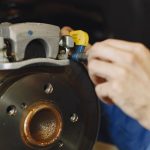If your car’s ride feels less smooth than before, or you notice uneven tire wear, bouncing, or drifting, it might be a sign of worn-out suspension components. In this article, we’ll explore the common signs indicating suspension issues and provide valuable insights into diagnosing the problem. Moreover, we’ll discuss practical solutions to restore your vehicle’s comfort and stability, ensuring an enjoyable driving experience.
Introduction
A well-maintained suspension system is crucial for a smooth and safe driving experience. In this article, we delve into the signs that your car’s suspension may be worn out and explore effective solutions to address these issues.
Recognizing Signs of Worn-out Suspension:
Uneven Tire Wear
Uneven tire wear is often a visible indicator of suspension problems. When your suspension system is compromised, tires may wear unevenly, leading to a shorter lifespan and reduced performance. Regularly inspect your tires for irregular patterns and address issues promptly.
Bouncing Sensation
If you experience a bouncing sensation while driving, it’s a clear sign of worn-out shocks or struts. These components play a crucial role in maintaining stability and control. Bouncing not only affects comfort but also poses safety risks, especially during sudden maneuvers or emergency stops.
Drifting on Turns
Drifting or pulling to one side during turns indicates an imbalance in your suspension system. This can make steering challenging and compromise your ability to navigate corners safely. Addressing this issue promptly is essential for maintaining optimal control and safety on the road.
Unusual Noises
Unusual sounds, such as clunking or creaking, can be indicative of worn-out suspension components. Identifying the source of these noises is crucial for effective diagnosis. From worn-out bushings to damaged shocks, each component can contribute to these sounds, warranting a thorough inspection.

Diagnosing Suspension Issues:
Visual Inspection
Perform regular visual inspections of your suspension components. Look for signs of damage, leaks, or excessive wear. Timely identification of issues through visual checks can prevent further damage and costly repairs.
Road Test
Take your car for a road test to assess its suspension performance. Pay attention to how it handles bumps, turns, and sudden stops. A road test provides valuable insights into the condition of your shocks, struts, and other suspension elements under real driving conditions.
Professional Inspection
For a comprehensive diagnosis, seek professional help. Experienced mechanics have the expertise to identify hidden suspension problems and use advanced diagnostic tools for accurate assessments. A professional inspection is crucial, especially if you’re unsure about the specific issue affecting your suspension.
Solutions for Worn-out Suspension:

Replacement of Shocks and Struts
Shocks and struts play a pivotal role in maintaining a smooth ride. If these components show signs of wear, replacement is necessary. Consider upgrading to high-quality shocks and struts to enhance your vehicle’s overall performance and comfort.
Inspecting and Replacing Bushings
Worn-out bushings can contribute to suspension issues. Inspect these rubber components for signs of deterioration and replace them if needed. Upgrading to polyurethane bushings can provide durability and better overall suspension performance.
Wheel Alignment
Proper wheel alignment is crucial for preventing uneven tire wear and maintaining stability. Address any misalignment promptly to ensure your suspension components work optimally. Regular alignment checks can significantly extend the lifespan of your tires and suspension system.
Upgrading Suspension Components
Consider upgrading your suspension components for improved performance. Aftermarket options offer a range of choices, allowing you to tailor your suspension setup to your driving preferences. From sportier handling to enhanced comfort, upgrading specific components can transform your driving experience.
Conclusion
Maintaining a healthy suspension system is vital for a safe and enjoyable driving experience. Regular inspections, prompt diagnosis, and appropriate solutions are key to addressing worn-out suspension issues. By taking proactive measures, you can ensure your car’s suspension remains in top condition, providing optimal comfort and safety on the road.
FAQs on Worn-out Suspension
Q1: How often should I check my car’s suspension?
Regularly inspect your suspension during routine maintenance checks or if you notice any signs of issues. Ideally, every 6 months is a good practice.
Q2: Can I drive with worn-out suspension temporarily?
While it’s possible, it’s not recommended. Worn-out suspension compromises safety and can lead to further damage. Address the issue as soon as possible.
Q3: Are aftermarket suspension components worth considering?
Yes, aftermarket components can offer improved performance and customization. However, choose reputable brands and consult with professionals for compatibility.
Q4: What other factors can contribute to uneven tire wear?
Alignment issues, improper tire inflation, and worn-out steering components can also contribute to uneven tire wear. Addressing these factors collectively ensures optimal tire performance.
Q5: How can I maintain my car’s suspension for longevity?
Regular inspections, prompt repairs, and following the manufacturer’s maintenance guidelines contribute to the longevity of your car’s suspension. Additionally, avoid rough driving conditions whenever possible.
Last Updated on March 6, 2024 by admin

Mac is an Automotive enthusiast. He owns up to 15 vehicles. He deals with Auto problems and shows his skill to Car owners who are seeking any type of Car help.





